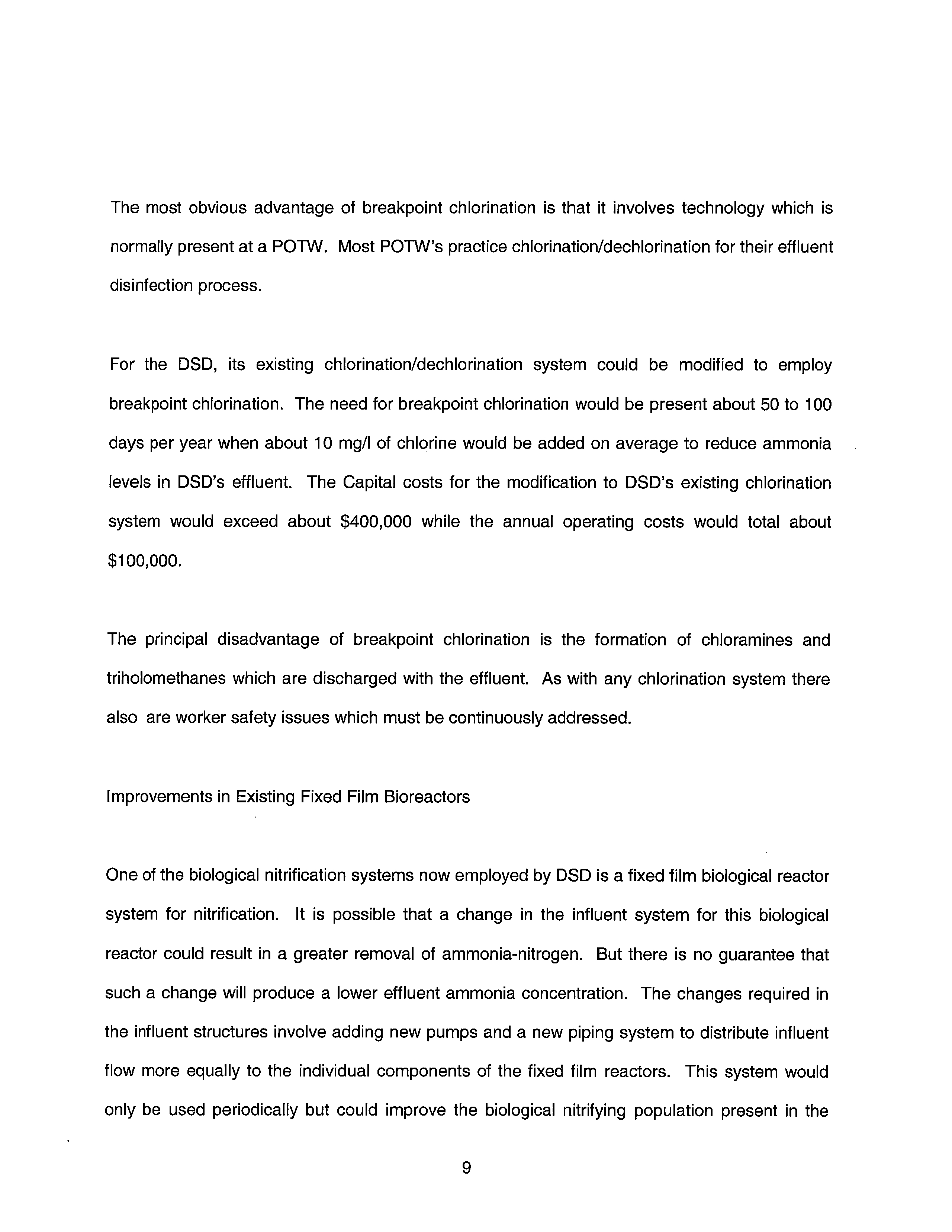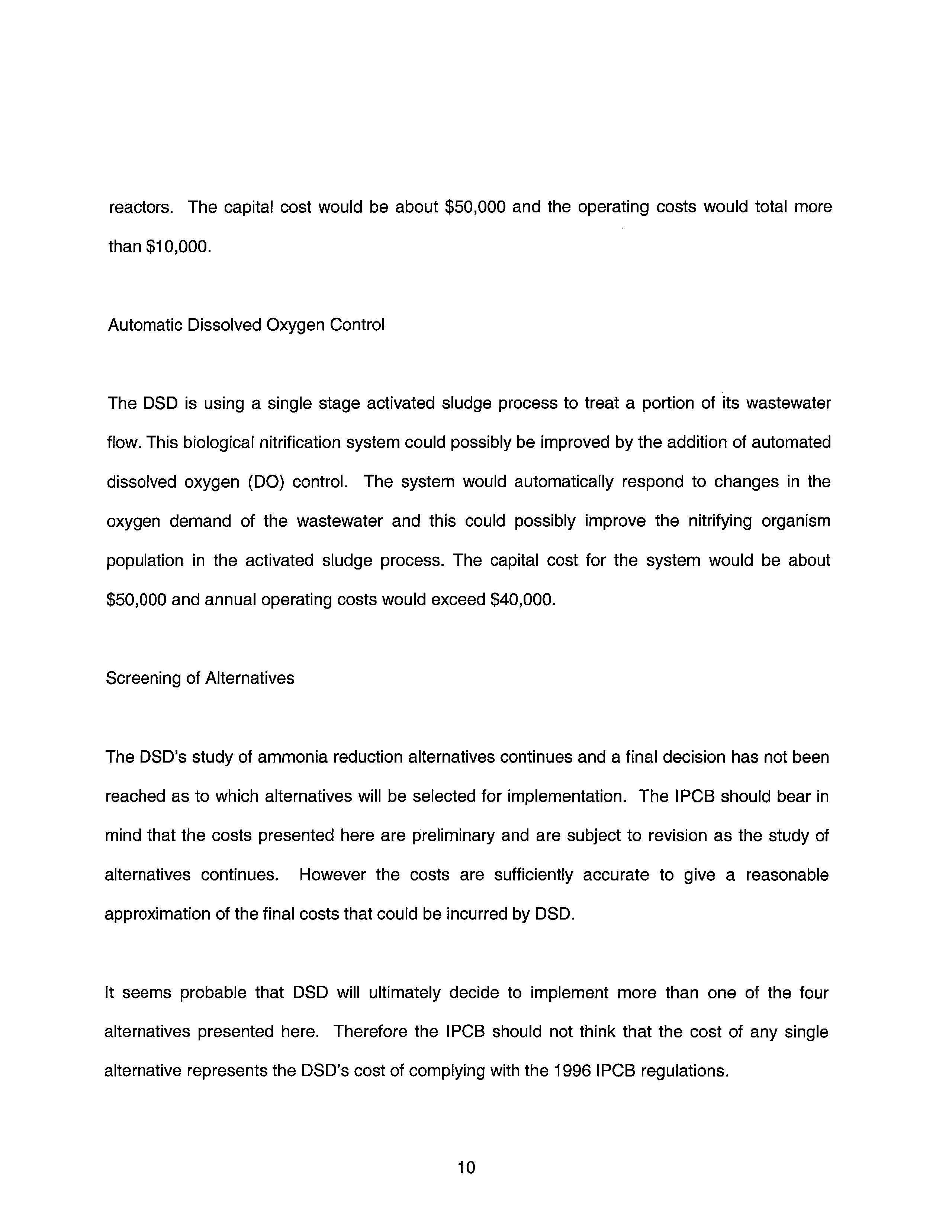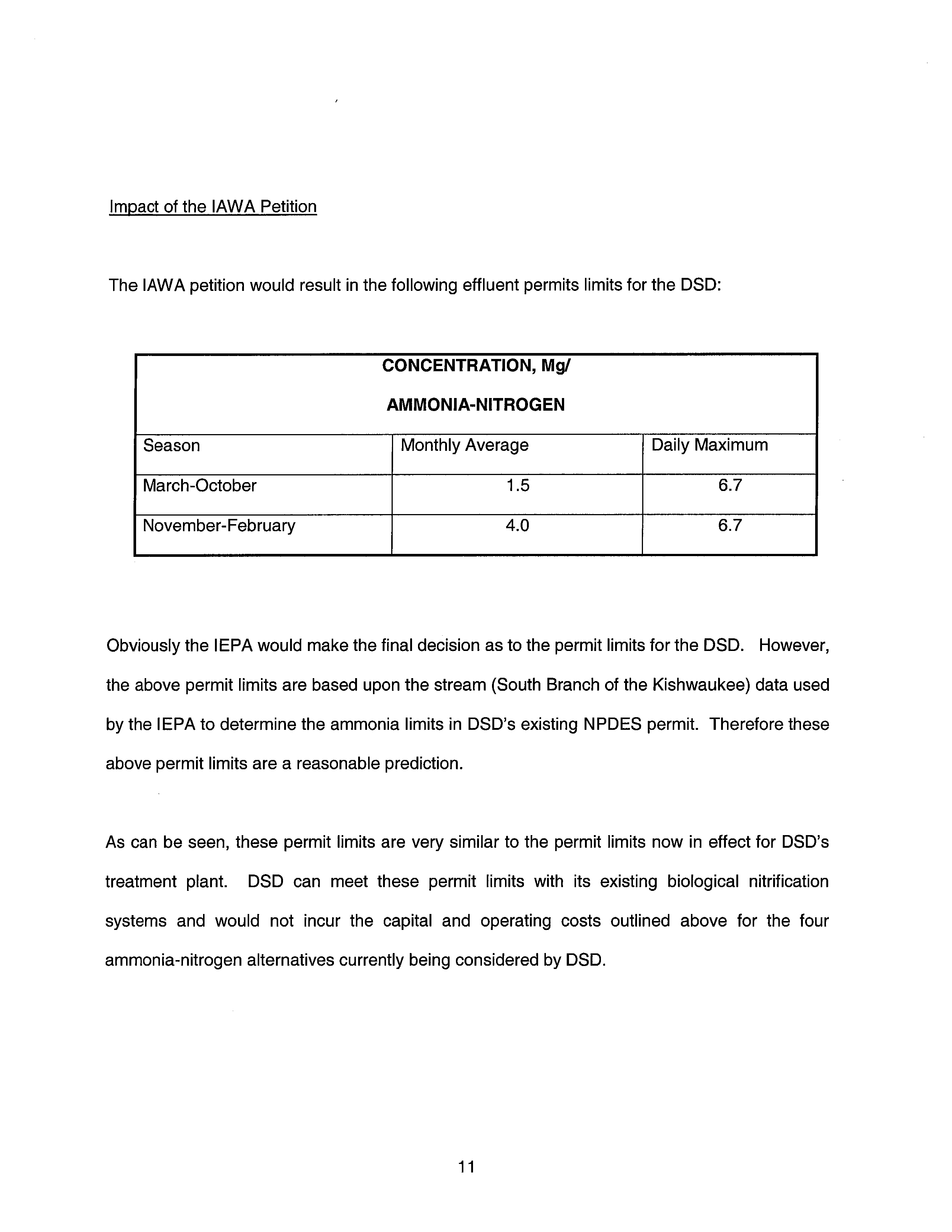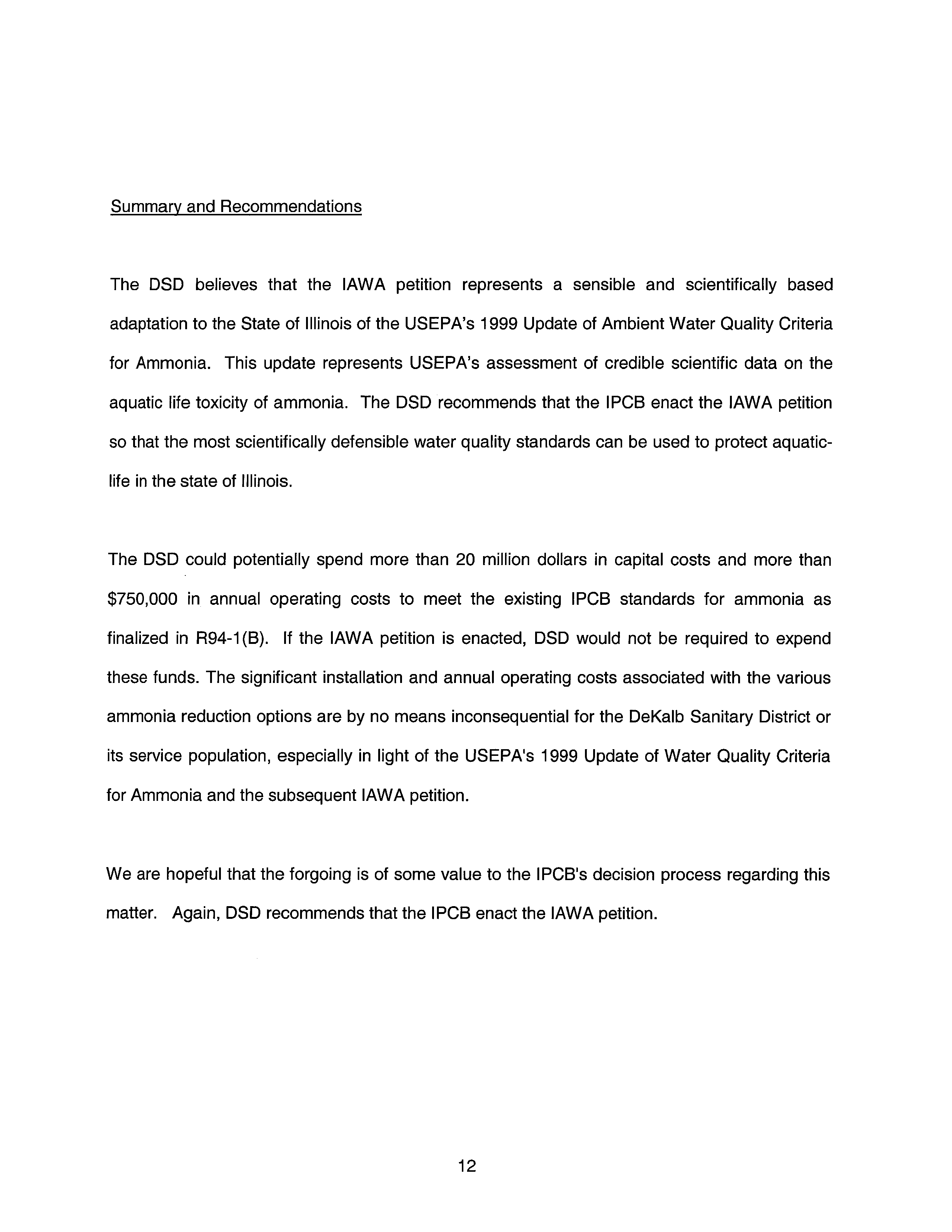BOARD OF
TRUSTEES
DENNISJ. COLLINS
PRESIDENT
TIMOTHY
A.
STRUTHERS
VICE
PRESIDENT
RONALD 0. NAYLOR
CLERK
February 25,
2002
Illinois
Pollution Control
Board
Docket Clerk
James R. Thompson Center
100 West Randolph Street
Suite 11-500
Chicago,
Illinois
60601
Subject:
Prefiled Testimony of Mr.
Michael Zima
Docket No.
R02-1 9
Attn:
Docket Clerk:
OFFICERS
MICHAEL ZIMA
MANAGER
JANICE TRIPP
ASST. MGR. ADMINISTRATION
DAVID PAULING
ASST.
MGR. OPERATIONS
RICHARD STOKKE
TREASURER
KEITH FOSTER
A1TORNEY
RECEIVED
CLER’~
~
MAR
4
2002
STATE OF IWNOIS
Pollutton
Control Board
Enclosed please find the testimony of Mr.
Michael Zima to be presented at the
Illinois
Pollution Control Board
(IPCB) Meeting of March 25,
2002.
This IPCB meeting
is
scheduled for
10:30 a.m.
and will take place at the James
R.
Thompson Center
in
Chicago.
The testimony will
be in the matter of the
Illinois Association of Wastewater
Agencies petition before the
IPCB
regarding ammonia-nitrogen water quality standards
in
Docket Number R02-19.
Please be aware that
I have served copies of the enclosed
testimony with
all persons
on the existing service list for R02-1 9.
If you have any questions, please
call
me at 815-758-3513.
Very truly yours,
Michael Zima
District Manager
Cc:
M. Callahan
D.
Zenz
D.
Schmidt
PHONE:
815-758-8611
FAX:
81 5-758-6615
RECEIVED
CLFR~’~
~
MAR
4
2002
TESTIMONY PRESENTED TO THE
ILLINOIS POLLUTION CONTROL BOARD
IN THE
MATTER OF:
STATE OF
ILLINOIs
Pollution Control Board
PETITION OF THE
ILLINOIS ASSOCIATION OF WASTEWATER AGENCIES
WATER QUALITY STANDARDS
AMMONIA-NITROGEN
DOCKET NUMBER:
R02-19
MARCH 25, 2002
BY
MR. MICHAEL ZIMA
DISTRICT MANAGER
DEKALB SANITARY DISTRICT
1
Introduction
The
Illinois
Association
of Wastewater Agencies
(IAWA)
has filed a
petition
before
the
Illinois
Pollution Control
Board (IPCB).
In this
petition,
the
IAWA
has proposed
a
change to Parts 302
and
304
of the
existing
IPCB
Water
Quality Standards
for
Ammonia.
The
IAWA
Petition
has
been assigned
Docket Number
R02-19
by the
IPCB
and public hearings on this
petition are
in
progress.
The
impetus
and genesis for
the
IAWA
petition
is
the
United
States
Environmental
Protection
Agency (USEPA)
1999 Update of Ambient Water Quality Criteria for Ammonia (EPA-822-R-99-
014)
which
was
released
in
the
Federal
Register
on
December
22,
1999
(Vol.
64,
No.
245,
Pages
71974-71980).
In
the
1999
update,
USEPA
took
note
of
the
fact
that
additional
information
has
been
gathered
since
it
published
its
Ambient Water
Quality
For
Ammonia
in
1984.
Based
upon
the
additional
information,
USEPA
prepared
the
1999
update
which
contained
revised freshwater quality criterion
for ammonia.
The
IAWA
petition essentially asks
the
IPBC to
enact
into
Illinois
Regulation,
USEPA’s
1999
Update
of Ambient
Water
Quality
Criteria for Ammonia.
The
USEPA
has
spent
considerable
effort
in
issuing
the
1999
update
and
the
states
are
expected
to
adopt
numeric water quality
criterion
for
ammonia
based
upon the
1999
update.
Protective criteria for ammonia
are expected to
be adopted in all states not later than 2004.
1
The DeKaIb Sanitary
District
The
DeKaIb
Sanitary
District (DSD)
was
created
on
July
12,
1928
and
for the
past nearly
74
years
has
provided
wastewater
collection
and
treatment
and
biosolids
management
for
its
Northern
Illinois
service
area.
By
1929,
the
DSD
provided primary and
secondary treatment to
its
entire
service area.
Since
1929,
the DSD
has
continuously upgraded its treatment
facilities.
In
1981,
DSD provided
second stage biological
treatment to
remove ammonia-nitrogen from it’s
effluent.
Also
in
1981,
tertiary sand filtration was
added
which greatly
reduced the suspended
solids and
oxygen
demand
of the DSD’s discharge.
In
1984,
DSD constructed
a
new facility to
treat
excess
flows
during
peak
flow
periods.
Most
recently
in
1997,
the
DSD
added
a
new
single stage
activated
sludge
nitrification
(ammonia
removal) facility to
handle
additional
flows
from
its
service
area.
A
new
headworks
was
also
constructed
in
1997
to
upgrade
the
raw
sewage
pumping and flow
measurement capabilities of the DSD’s treatment plant.
Since
1981,
the
DSD
has
spent
nearly
20
million
dollars
to
provide
modern
wastewater
treatment to
the nearly 40,000 people
in
the service
area. Today the DSD
provides
complete
secondary and
tertiary treatment and biological
nitrification (ammonia removal)
before discharge
to the South
Branch
of the Kishwaukee River.
Testimony of the DeKaIb Sanitary District
The testimony
of the DSD
before the IPCB will focus on the discharge permit limits which will
be
imposed
upon
the
DSD
based
upon
IPCB’s
existing
water
quality
standards
for
ammonia-
nitrogen
and
the economic
impact
of these
regulations.
Also the DSD
will discuss
the permit
2
limits which would
be
imposed
if
the IAWA petition
were to
be
enacted
and
the impact of
such
enactment on the
DSD.
The DSD
believes
that
it
is important
for
the
IPCB
to
understand
the
economic
impact
of
its
existing
ammonia-nitrogen
regulations on
publicly
owned treatment
works
(POTWs)
and
how
the IAWA petition
would affect this
impact.
IPCB Ammonia-Nitroçjen Water Quality Standards
The IPCB
in
December
1996 R94-1
(B)
adopted the existing
State
of Illinois
ammonia-nitrogen
and
un-ionized ammonia standards.
The IPCB 1996 water quality standards were
in
response
to the development of the USEPA’s
National Criteria Document for Ammonia
in
1984.
Because
of
the
release
of
USEPA’s
1999
update,
it
seems
entirely
logical
for
the
IPCB
to
consider
a
significant change
in
its 1996 water quality standards for ammonia.
The USEPA’s
1999
Update
of
Water Quality
Criteria for Ammonia was
published
only after
an
extensive review
of
the scientific
literature.
Upon
releasing the
1999
update,
USEPA
stated,
“These criteria
reflect the latest scientific
knowledge on the effects water pollutants
have on the
public
health and
welfare,
aquatic
life
and
recreation.
The
1999 update contains
EPA’s
most
recent
freshwater
aquatic
life
criteria
for
ammonia
and
supercedes
all
previous
freshwater
aquatic
life ammonia
criteria.
The new criteria
reflect recent
research
and data
since
1984 and
are a revision
of several elements
in the 1984 criteria...”
3
The DSD believes that the IAWA has
made an
honest and scientifically defensible adaptation
of
the
1999 update to fit the situation here in
Illinois.
The IAWA has
had
the petition
reviewed
by
the
IEPA and they are in
concurrence with
it.
The DSD
believes
that
the
IAWA petition
should
be adopted
in
its
present
form.
The
petition
accurately
reflects
the
USEPA’s
1999
update
and
therefore
represents
the
latest
scientific
knowledge. We urge the IPCB to enact the IAWA petition.
DeKaIb
Sanitary
District
National
Pollutant
Discharcie
Elimination
System
(NPDES)
Permit
Limits
The existing
NPDES
permit
for the DSD was
issued
on
December
12, 2000.
The IEPA issued
this
permit
after
finalizing
its
Part
355
procedures
for
ammonia-nitrogen.
These
IEPA
procedures were
issued on July
1,
1999.
For the period of
December 2000 through December 2003, the NPDES permit
requires the DSD
to meet the following ammonia-nitrogen limits.
CONCENTRATION, Mg/I
AMMONIA-NITROGEN
Season
Monthly Average
Daily Maximum
April-October
1 .5
3.0
November-March
3.6
7.2
4
These limits
are the same
ammonia-nitrogen limits that
have
been
in
previous
NPDES
permits
for DSD.
Special
Condition
16
of
DSD’s
NPDES
permit
states
that
by December
2003,
the
DSD
must
meet the following ammonia-nitrogen permit limits:
CONCENTRATION, Mg/I
AMMONIA-NITROGEN
Season
Monthly Average
Daily Maximum
April-October
1 .3
3.0
November-March
1 .2
5.1
The December
2003 permit
limits are
based upon the
IPCB water quality standards adopted
in
1996 and the
Part 355
procedures adopted
by the IEPA
in
1999.
Those
NPDES
permits which
expired
after
July,
1999
contains
limits
based
upon the
1996
IPCB
standards
and
the
1999
IEPA procedures.
Those
who
could
not
comply
with
the
new
limits
were
given three
years
to
comply.
Hence the DSD now has
a December 2003 compliance date
in
its NPDES permit.
DSD’s Alternatives to Meet the December 2003 Permit Limits
In order to
meet the December 2003 permit limits for ammonia-nitrogen, the DSD
is considering
a
variety of alternatives.
The DSD
has
retained Consoer Townsend
Envirodyne
Engineers
Inc.
(CTE)
to
study and
select the most cost-effective
alternative or alternatives which can meet the
December 2003 limits.
5
Biological Nitrification
(ammonia removal)
Almost without exception,
POTWs
in
Illinois
remove ammonia from
wastewater using
biological
nitrification.
In
essence,
nitrifying
bacteria
contained
in
biological
reactors
convert
the
toxic
ammonia
to
non-toxic
nitrates
before
discharge.
But
the
biological
nitrification
reaction
is
somewhat difficult to control
and
it is often
not always possible
to consistently achieve
levels of
ammonia-nitrogen below
1 .5 mg/I.
In the
IPCB hearing on
R94-1 (B),
the IEPA (Mr.
Dean Studer,
November 10,
1994) testified
that
biological
nitrification
is capable
of
consistently achieving a monthly average ammonia-nitrogen
concentration
of
1.5
mg/I
from
April-October
and
4.0
mg/I,
November-March.
It was
for
this
reason that
in
R94-1
(B), the
IPCB
decided
to establish
the concept
of effluent modified waters
(EMW).
EMWs
are waters
downstream from
a wastewater treatment plant that,
at a minimum,
can comply with a summer monthly average of
1.5 mg/I from April through October
and a winter
monthly
average
of
4.0
mg/I
during
November-March.
EMW’s
continue
downstream
of
the
facility, the distance that it takes for the chronic ammonia standards to be met.
The
DSD
must
essentially
comply
with
a
monthly
average
ammonia-nitrogen
permit
limit
by
December
2003
of
1.2-1.3.
mg/I,
year
round.
The
DSD
employs
biological
nitrification
and
meets its
existing NPDES permit limits of
1 .5 mg/I April-October and 3.6 mg/I,
November-March.
But the December 2003 limits cannot
be consistently met with the biological
nitrification systems
currently
in place.
6
This non-compliance
with
the 1996
IPCB
standards
using biological
nitrification
is not atypical.
In fact the IEPA stated
in testimony
on
R94-1(B) that at
least
19 facilities in
Illinois were
at risk
of
non-compliance
if
the
1996
IPCB
standards
were
adopted.
The
IEPA
indicated
in
its
testimony
that
most
of
the
19
facilities
will
have
to
be
redesigned
to
meet
the
proposed
standards.
Alternatives to
Reduce Ammonia-Nitrogen
in
DSD’s Effluent
DSD’s Consultant
(CTE Engineers)
is currently considering the following
alternatives
to
reduce
effluent ammonia-nitrogen in
order to comply with
its December 2003 permit limits:
1)
Ion Exchange
2)
Breakpoint Chlorination
3)
Improvements in
Fixed
Film Bioreactors
4)
Automatic
Dissolved Oxygen Control for the Single Stage
Nitrification System
Ion
Exchange
Ion
exchange
involves passing
a
liquid
through
a
column
or bed
of specific
natural or synthetic
resin and the exchange
of one
ion for another.
Clinoptilolite is the
resin
of choice for ammonia-
nitrogen
removal.
Ammonia-nitrogen
concentrations
of
0.5
to
1
.0
mg/I
are
possible
with
this
technology.
7
The 5
mgd
North
Tahoe-Truckee Wastewater Treatment
Plant has
used
ion
exchange
to treat
its discharge
to Lake Tahoe since the 1970’s.
Ion
exchange
is
a
workable
but
an
extremely
demanding
operation.
The
resin
must
be
frequently acid
washed
to
remove
scale
formation.
About
20
of
the
resin
must
be
replaced
per year. The
resin
regeneration process
presents
a extremely corrosive environment dictating
special
safety
concerns.
The
equipment
is
also
difficult
to
maintain,
repair
and
replace.
Operational
care
is
particularly
important
in
terms
of
preventing
ammonia
salt
crystallization
formation
which can contaminate the resins.
For
the
DSD,
the
capital
cost
for
ion
exchange
treatment plant
to
reduce
ammonia-nitrogen
levels
below
1 .5
mg/I
would
cost
approximately 20
million
dollars
and
annual
operating
costs
could exceed $600,000 dollars per year.
Breakpoint Chlorination
Breakpoint
chlorination
involves
adding
sufficient
chlorine
to
a
wastewater
to
oxidize
the
ammonia present.
Most
of the
ammonia-nitrogen is converted
to
nitrogen
gas
by the reaction
with
chlorine.
It normally takes about
10
mg/I of
chlorine
to
remove
1
mg/I of ammonia-nitrogen.
Dechlorination of the effluent is necessary because of
residual chlorine present at the end
of the
breakpoint reaction.
8
The
most
obvious
advantage
of
breakpoint
chlorination
is that
it
involves
technology
which is
normally present at
a POTW.
Most
POTW’s practice chlorination/dechlorination for their effluent
disinfection process.
For
the
DSD,
its
existing
chlorination/dechlorination
system
could
be
modified
to
employ
breakpoint chlorination.
The need for breakpoint chlorination
would
be
present about 50 to
100
days per year when about
10
mg/I of
chlorine
would
be
added
on
average
to
reduce ammonia
levels
in
DSD’s
effluent.
The
Capital
costs
for
the modification
to
DSD’s existing
chlorination
system
would
exceed
about
$400,000
while
the
annual
operating
costs
would
total
about
$100,000.
The
principal
disadvantage
of
breakpoint
chlorination
is
the
formation
of
chloramines
and
triholomethanes
which are
discharged
with
the effluent.
As with
any chlorination
system
there
also
are worker safety issues which must be continuously addressed.
Improvements
in
Existing
Fixed
Film Bioreactors
One of the biological
nitrification
systems now employed
by
DSD is a fixed film biological
reactor
system
for
nitrification.
It
is
possible
that
a
change
in
the
influent system
for
this
biological
reactor
could result
in
a
greater
removal
of
ammonia-nitrogen.
But there
is
no
guarantee
that
such
a change
will produce
a
lower effluent
ammonia
concentration.
The changes
required
in
the influent structures
involve adding
new pumps
and
a
new piping
system
to distribute influent
flow
more
equally to
the individual
components
of
the fixed
film
reactors.
This
system
would
only
be
used
periodically
but could
improve the
biological
nitrifying
population
present
in
the
9
reactors.
The
capital cost would
be
about
$50,000
and
the operating
costs
would
total
more
than $10,000.
Automatic
Dissolved Oxygen Control
The
DSD
is using
a single
stage
activated
sludge
process
to treat
a portion
of
its
wastewater
flow. This biological
nitrification
system could possibly be
improved by the addition
of automated
dissolved
oxygen
(DO)
control.
The
system
would
automatically
respond
to
changes
in
the
oxygen
demand
of
the
wastewater
and
this
could
possibly
improve
the
nitrifying
organism
population
in
the
activated
sludge
process.
The
capital
cost
for
the
system
would
be
about
$50,000 and annual
operating costs would exceed $40,000.
Screening of Alternatives
The DSD’s study of ammonia reduction alternatives
continues and a final decision
has not
been
reached
as to which alternatives
will
be
selected for
implementation.
The
IPCB
should
bear in
mind
that the costs
presented
here
are
preliminary
and
are
subject
to
revision
as the study of
alternatives
continues.
However
the
costs
are
sufficiently
accurate
to
give
a
reasonable
approximation of the final costs that could be incurred
by DSD.
It
seems
probable
that
DSD
will
ultimately
decide
to
implement
more
than
one
of
the
four
alternatives
presented
here.
Therefore
the
IPCB
should
not think
that
the cost
of
any
single
alternative
represents the DSD’s cost
of complying with the 1996 IPCB
regulations.
10
Impact
of the IAWA Petition
The IAWA petition would
result in the following effluent permits limits for the DSD:
CONCENTRATION,
Mg/
AMMONIA-NITROGEN
Season
Monthly Average
Daily Maximum
March-October
1 .5
6.7
November-February
4.0
6.7
Obviously the IEPA would
make the final decision as to
the permit
limits for the DSD.
However,
the above permit limits are
based upon the stream (South
Branch of
the Kishwaukee)
data used
by the IEPA to determine
the ammonia limits
in
DSD’s existing NPDES
permit.
Therefore these
above permit limits are a reasonable prediction.
As
can
be
seen, these
permit limits are
very similar to the permit
limits
now
in
effect for
DSD’s
treatment
plant.
DSD
can
meet
these
permit
limits
with
its
existing
biological
nitrification
systems
and
would
not
incur
the
capital
and
operating
costs
outlined
above
for
the
four
ammonia-nitrogen alternatives currently being
considered by DSD.
11
Summary and Recommendations
The
DSD
believes
that
the
IAWA
petition
represents
a
sensible
and
scientifically
based
adaptation to the State of
Illinois of the USEPA’s 1999
Update
of Ambient Water Quality Criteria
for
Ammonia.
This
update represents
USEPA’s
assessment
of
credible
scientific
data
on
the
aquatic life toxicity
of
ammonia.
The DSD
recommends
that the
IPCB enact the
IAWA
petition
so that the most scientifically defensible water quality standards can
be
used to protect aquatic-
life in the state
of Illinois.
The DSD
could
potentially spend
more
than
20
million
dollars
in
capital costs
and
more
than
$750,000
in
annual
operating
costs
to
meet
the
existing
IPCB
standards
for
ammonia
as
finalized
in
R94-1 (B).
If
the
IAWA
petition
is enacted,
DSD
would
not
be
required
to
expend
these
funds. The significant installation
and annual
operating
costs associated with
the various
ammonia reduction options are by no
means
inconsequential for the DeKaIb Sanitary
District or
its
service
population, especially
in
light of the
USEPA’s
1999
Update
of
Water Quality Criteria
for Ammonia and the subsequent
IAWA petition.
We are
hopeful that the forgoing
is of some value to the
IPCB’s decision
process regarding this
matter.
Again,
DSD recommends that the
IPCB enact the IAWA petition.
12















